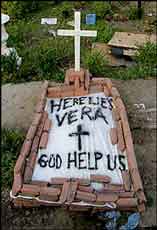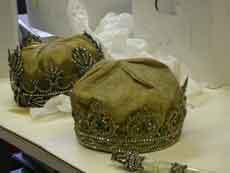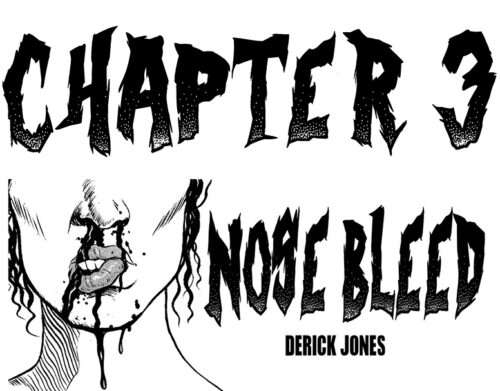[Ed. note: DC-area artist and blogger James Bailey — a Mississippi native who lived for 20 years in New Orleans — sent me a link to this story in yesterday’s NY Times. He’s quoted at the end of the article saying some pretty heartfelt and heart-breaking stuff. I want to share the entire article with you. Bailey, whose “Burnversion” project I’ve been meaning to tell you about, has put his life on hold to go down to the coast and help with the relief effort, especially anything having to do with art institutions. We wish him well and are all holding our breath to see how the museums and collections fare. Read more about Bailey, his art, and his interest in art institutions at his blog black cat bone.]
Toll Is Also Exacted on Gulf Region’s Historical and Cultural Treasures
By DANIEL J. WAKIN
Published: September 4, 2005

The hurricane and the flood that followed took their toll on the cultural riches of New Orleans and the cities in its orbit.
Museum directors were still struggling to gain a clear picture of the extent of losses, but some collections seem to have been spared, including the core holdings of the New Orleans Museum of Art, one of the most important in the Deep South.
The Hogan Jazz Archive at Tulane University, which has the world’s largest jazz oral history collection, appeared to be safe, said the curator, Bruce Raeburn. Preservation Hall, the 255-year-old French Quarter building that serves as a jazz shrine and performance site, appears to be undamaged. But the roof of the Old U.S. Mint in the French Quarter was damaged, raising concern for the state of its jazz collection, which includes musical instruments, film, posters and photographs.
(Image is photo by Dave Martin/Associated Press, from the NY Times. Here’s the caption: A makeshift tomb in New Orleans conceals a body that had been lying on the sidewalk for days. President Bush has defended the federal response to the hurricane but said the results of the effort were “unacceptable.”)
Seven staff members of the New Orleans Museum of Art, including security guards and engineers, stayed behind Tuesday to protect the collection and were presumably there through the week, said E. John Bullard, the museum’s director.
The Times-Picayune newspaper reported that about 30 relatives of museum staff members had sought refuge in the building, which is on high ground at the edge of City Park. It said the staff members refused to leave the building untended when urged to leave by officials of the Federal Emergency Management Agency, who arrived there Wednesday.
Mr. Bullard, who was vacationing in Maine, said Friday that he had heard nothing more.
bailey, james
“The ones who stayed are really the heroes for the museum,” he said.
The museum, which has about 40,000 objects in its collection, has a prominent group of Miró works and other paintings, 16,000 pieces of glass, and major photography holdings. It has an important African collection, and about 100 of the best pieces from it are on tour right now.
Mr. Bullard, who has been director of the museum since 1973, feared for an outdoor sculpture garden established two years ago containing 55 works, including pieces by Henry Moore, Louise Bourgeois and Claes Oldenburg. Oak trees towered above.
A 45-foot-tall steel tube and cable sculpture by Kenneth Snelson, “Virlane Tower,” valued at more than $500,000, was smashed, The Times-Picayune said. The other major concern was basement storage spaces. There was only enough fuel for the emergency generators, which operate sump pumps and climate control systems, to last until the middle of last week.
If water invades and the pumps fail, it could threaten thousands of photographs and prints. Mr. Bullard said the museum’s insurers had dispatched private security guards from Florida in two campers to protect the artwork and seek out fuel to keep the generators going. The next task would be to transport important artworks out of the city when roads were passable.
“This is a transforming event in a city’s life,” he said. “Even though New Orleans has been around for 200 years, I wonder whether it can survive.”
The failure of climate control systems in other surviving museums poses a danger, said Ed Able, president of the American Association of Museums in Washington. He said 126 institutions – art museums, zoos, aquariums and others – lay within the affected zone.

“All in all, we’ve got definite collection damage across the affected areas,” he said. Added to that were fears that dozens of historic houses – blips on the nation’s cultural radar but important parts of the gulf region’s identity – had been smashed into oblivion. (image is one I took in Feb. 2004 of antique Mardi Gras crowns which are part of the Historic New Orleans Collection. They were on their way to a temporary display at Brennans restaurant which was holding the ball for the Rex krewe I believe. See bigger.)
Beauvoir, the home of Jefferson Davis in Biloxi, Miss., suffered serious harm, Mr. Able said. Completed in 1851, the site included the Davis presidential library.
The Dantzler House historic mansion in Biloxi was destroyed.
The Ohr-O’Keefe Museum of Art, a partly built complex of five buildings designed by Frank Gehry, also in Biloxi, was heavily damaged when a floating casino was deposited in its midst. The African-American arts gallery at the complex was demolished, according to Mr. Gehry’s office. At least two other exhibit centers appeared to have been spared.
Ground was broken for the $30 million museum in 2003, and it was expected to open next year. One building was to be dedicated to the works of George Ohr (1857-1918), a major American ceramicist known as the Mad Potter of Biloxi.
The fate of Ohr’s work, much of which was located in the Biloxi Library and Cultural Center, was not known for certain, although the museum’s executive director, Marjie Gowdy, said, “We believe the pottery is intact.” She posted the comment on the Web site of The Sun Herald newspaper in Biloxi. (In Ohr’s lifetime, a fire destroyed his studio and much of his work up to then.)
Historic buildings in the French Quarter in New Orleans – the Cabildo, the Presbytere and the Old U.S. Mint – sustained some damage, according to the Association of Art Museums, which has set up a Web page on the effects of Katrina (aam-us.org/aamlatest/news/Hurricane FirstReports.cfm).
The buildings are operated by the Louisiana State Museum. Their collections of archives, books and documents “are in better shape than feared,” the association said.
Water poured through a blown-off section of roof at the Old Capitol Museum of Mississippi History in Jackson and left hundreds of pieces soggy, ruining some, the association’s Web site said.
Like utility company teams from elsewhere volunteering their services, conservation experts, through the Southeastern Regional Conservation Association, have offered help in restoring damaged artworks. The Southeastern Museums Conference in Atlanta is helping organize relief for beleaguered museums.
The 1921 Orpheum Theater, a former vaudeville hall where the Marx Brothers, Burns and Allen and other acts played, probably suffered water damage. It is the home of the Louisiana Philharmonic Orchestra. The orchestra’s treasurer and timpanist, Jim Atwood, said he saw television video of the area around it showing high waters.
He said his two sets of timpani, valued at a total of $40,000, were in the basement and probably severely damaged. One set was one of six made by a prominent maker in Dresden, Germany, that closed down about a decade after the end of World War II. The orchestra library of scores and parts was stored on the sixth floor of another building, and is presumably safe, he said.
The flood was a second recent blow to the orchestra, which was reconstituted by the musicians in 1991 after the New Orleans Symphony declared bankruptcy. “We’re hoping against hope we can keep it afloat after this,” said Mr. Atwood, who was speaking from his cabin in Livermore, Colo.
He said the prospects for the orchestra’s players would be particularly tough if it failed. “To have a job as a professional musician, a full-time job, is a very precious things these days,” he said. “I just hate the thought of all my colleagues having their jobs slip through their fingers.”
Efforts were under way to find temporary work for the Louisiana Philharmonic musicians as substitutes and extra players in orchestras around the country.
The cultural losses produced anguish among the city’s musicians and artists and hope that they will be restored. “Great cities are defined by great art,” Mr. Atwood said.
James W. Bailey, an art photographer who grew up in Mississippi and lived in New Orleans for 20 years, said he had taken thousands of pictures of the city.
“In my life in Mississippi, I dreamed about being an artist,” Mr. Bailey said. “It wasn’t until I moved to New Orleans that I became one.”
He described the city’s spirit as “absolutely mystical and magical and profoundly spiritual,” a spirit that gave rise to an artistic legacy that spread through the world.
“The fact that we are on the verge of losing this is hard to believe,” he said. “It has not sunk in that there is the possibility in the next few days that the city of New Orleans is going to be shut down, turned off and turned into a ghost land.”










